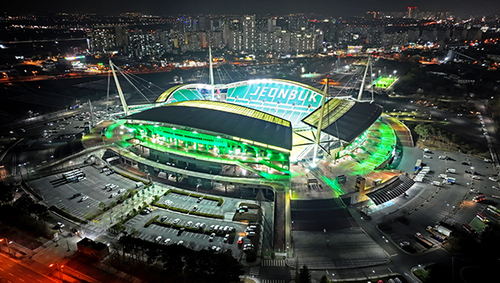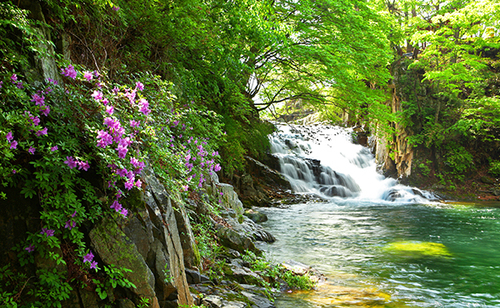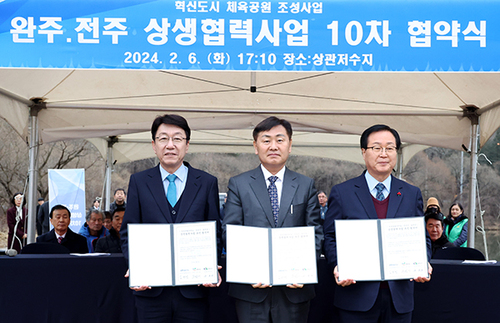| ▲ 우리나라 북서쪽에 위치한 몽골과 중국 고비사막에서 지난 26일부터 발원한 황사가 유입되면서 전북 중부권역과 동부권역에 '미세먼지(PM10) 주의보'가 발령돼 건강관리에 각별한 주의가 요망된다. / 도표제공 = 전북도 보건환경연구원 © 이요한 기자 |
|
우리나라 북서쪽에 위치한 몽골과 중국 고비사막에서 발원한 황사가 유입되면서 전북 중부권역과 동부권역에 '미세먼지(PM10) 주의보'가 발령돼 건강관리에 각별한 주의가 요망된다.
28일 전북도 보건환경연구원은 "지난 26일부터 고비사막에서 발원한 황사가 북서 기류를 타고 도내에 유입돼 이날 오후 3시 현재 순창 196ㆍ전주 186ㆍ완주 185ㆍ임실 184 μg/m3으로 '매우 나쁨'농도를 나타내고 있다"고 밝혔다.
이번 도내 황사 유입은 올 들어 4번째로 저기압인 비구름이 자주 통과하면서 상승 기류를 타고 사막의 먼지가 수시로 공중으로 떠오르면서 북서풍에 실린 황사 먼지가 한반도 부근에 고기압이 자리 잡아 하강 기류가 만들어지면서 고스란히 우리나라로 떨어져 2019년 2회ㆍ2020년 2회에 비해 자주 발생하고 있다.
황사가 발생했거나 미세먼지 농도가 높을 경우, 어린이ㆍ노약자ㆍ호흡기ㆍ심장 질환자 같은 민감군은 물론 일반인도 실외활동이나 과격한 운동을 자제해야 한다.
건강한 성인도 외출 및 야외활동은 가급적 자제하고 부득이하게 야외 활동을 할 경우 일반 마스크 대신 KF94 또는 KF80 보건용 마스크 또는 보호안경을 반드시 착용하는 등 차량운행 역시 자제해야 한다.
전북도 보건환경연구원 박정제 환경연구부장은 "유치원과 학교에서는 실외수업 자제 및 금지하고 부득이하게 실외활동을 할 경우, 반드시 마스크나 보호안경을 착용해야 한다"며 "가급적 차량운행도 자제해 줄 것"을 당부했다.
그러면서 "황사의 영향은 변동성이 있는 만큼, 한국환경공단에서 운영하는 에어코리아와 기상청 및 기상정보 등을 참고하면 도움을 받을 수 있다"며 "전북도 실시간 대기정보시스템을 통해 예보와 경보상황을 문자로 받아볼 수 있다"고 덧붙였다.
한편 '미세먼지'는 우리 눈에 보이지 않을 정도로 작은 먼지로 입자 크기에 따라 직경 10㎛ 이하(10㎛은 0.001㎝)인 것을 미세먼지(PM10)라고 한다.
직경 2.5㎛ 이하인 것을 '초미세먼지(PM2.5)'로 지칭된다.
이들 먼지는 매우 작아 숨을 쉴 때 폐포 끝까지 들어와 바로 혈관으로 들어갈 수 있으며 봄철인 3월은 통상 '초미세먼지(PM2.5)' 농도가 연중 가장 높아 건강관리에 각별히 주의해야 한다.
황사로 인한 미세먼지 '매우 나쁨(일평균 PM10 150㎍/㎥ 초과)' 예보 시에는 '관심' 단계가 발령되고 시간당 평균농도가 300㎍/㎥이상 2시간 지속될 경우 '경보'가 발령되고 황사에 의한 대규모 재난이 발생할 가능성이 높을 때는 '주의' 단계가 내려진다.
PM10 시간당 평균농도가 800㎍/㎥이상 2시간 지속될 것으로 예상될 때는 '경계'ㆍ2,400㎍/㎥이상이 24시간 지속 후 24시간 지속 예상 또는 미세먼지(PM10) 1시간 평균농도가 1,600㎍/㎥이상이 24시간 지속 후 48시간 지속 예상 시에는 '심각' 단계가 각각 발령된다.
☞ 아래는 위 기사를 구글 번역이 번역한 영문의 '전문'이다.
【Below is the 'full text' of an English article translated from the above article with Google Translate.】
Jeonbuk… The fourth 'yellow sand' inflow this year
Central and eastern regions, fine dust advisory is issued and outdoor activities should be carried out
Reporter Lee Yohan
As yellow dust originated from Mongolia and China's Gobi Desert, which is located in the northwest of Korea, a fine dust (PM10) advisory is issued in the central and eastern regions of Jeollabuk-do.
On the 28th, the Jeonbuk-do Institute of Health and Environment said, "Since the 26th, the yellow dust originated from the Gobi Desert has flowed into the province through the northwest air current. 'It shows the concentration.'
This is the fourth inflow of yellow sand into the province this year. As rain clouds, which are low atmospheric pressure, frequently pass through, dust from the desert frequently rises into the air through an upward air current. It is more frequent than 2 times in 2019 and 2 times in 2020.
When yellow dust occurs or the concentration of fine dust is high, sensitive groups such as children, the elderly, respiratory and heart disease patients, as well as the general public, should refrain from outdoor activities or excessive exercise.
Even healthy adults should refrain from going out and doing outdoor activities as much as possible, and should also refrain from driving a vehicle, such as wearing a KF94 or KF80 health mask or goggles instead of a regular mask when outdoor activities are unavoidable.
Jeong-je Park, head of the Environmental Research Department, Jeonbuk-do Health and Environment Research Institute, said, "Kindergartens and schools refrain from or prohibit outdoor classes, and if you inevitably engage in outdoor activities, you must wear a mask or goggles." Asked.
"As the impact of yellow dust is volatile, you can get help by referring to Air Korea, the Meteorological Agency, and meteorological information operated by the Korea Environment Corporation." You can receive it," he added.
On the other hand, 'fine dust' is small enough to be invisible to our eyes, and it is called fine dust (PM10) that has a diameter of 10㎛ or less (10㎛ is 0.001cm) depending on the particle size.
Those with a diameter of 2.5 μm or less are referred to as 'ultra-fine dust (PM2.5)'.
These dusts are very small, and when you breathe, they can enter the alveoli and enter the blood vessels immediately. In March, the spring season, the concentration of 'ultra-fine dust (PM2.5)' is usually the highest throughout the year, so you should pay special attention to health care.
In the case of forecasting'very bad (daily average PM10 exceeds 150㎍/㎥)', the 'interest' stage is issued, and if the average concentration per hour lasts more than 300㎍/㎥ for 2 hours, a 'alarm' is issued and When there is a high likelihood of a large-scale disaster caused by a disaster, the'Caution' step is taken.
When the average concentration per hour of PM10 is expected to last more than 800㎍/㎥ for 2 hours, it is expected that more than 2,400㎍/㎥ lasts for 24 hours and then continues for 24 hours or the average concentration of fine dust (PM10) for one hour is 1,600㎍/㎥ If the abnormality lasts for 24 hours and then is expected to last for 48 hours, each of the 'Severe' stages is issued.





















 많이 본 뉴스
많이 본 뉴스











